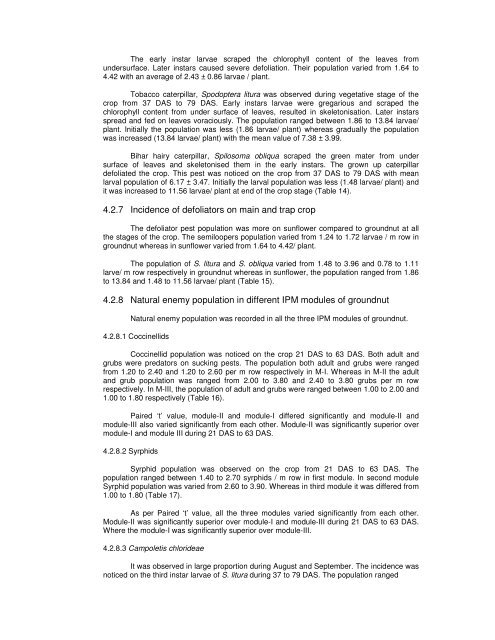screening elite genotypes and ipm of defoliators in groundnut
screening elite genotypes and ipm of defoliators in groundnut
screening elite genotypes and ipm of defoliators in groundnut
You also want an ePaper? Increase the reach of your titles
YUMPU automatically turns print PDFs into web optimized ePapers that Google loves.
The early <strong>in</strong>star larvae scraped the chlorophyll content <strong>of</strong> the leaves from<br />
undersurface. Later <strong>in</strong>stars caused severe defoliation. Their population varied from 1.64 to<br />
4.42 with an average <strong>of</strong> 2.43 ± 0.86 larvae / plant.<br />
Tobacco caterpillar, Spodoptera litura was observed dur<strong>in</strong>g vegetative stage <strong>of</strong> the<br />
crop from 37 DAS to 79 DAS. Early <strong>in</strong>stars larvae were gregarious <strong>and</strong> scraped the<br />
chlorophyll content from under surface <strong>of</strong> leaves, resulted <strong>in</strong> skeletonisation. Later <strong>in</strong>stars<br />
spread <strong>and</strong> fed on leaves voraciously. The population ranged between 1.86 to 13.84 larvae/<br />
plant. Initially the population was less (1.86 larvae/ plant) whereas gradually the population<br />
was <strong>in</strong>creased (13.84 larvae/ plant) with the mean value <strong>of</strong> 7.38 ± 3.99.<br />
Bihar hairy caterpillar, Spilosoma obliqua scraped the green mater from under<br />
surface <strong>of</strong> leaves <strong>and</strong> skeletonised them <strong>in</strong> the early <strong>in</strong>stars. The grown up caterpillar<br />
defoliated the crop. This pest was noticed on the crop from 37 DAS to 79 DAS with mean<br />
larval population <strong>of</strong> 6.17 ± 3.47. Initially the larval population was less (1.48 larvae/ plant) <strong>and</strong><br />
it was <strong>in</strong>creased to 11.56 larvae/ plant at end <strong>of</strong> the crop stage (Table 14).<br />
4.2.7 Incidence <strong>of</strong> <strong>defoliators</strong> on ma<strong>in</strong> <strong>and</strong> trap crop<br />
The defoliator pest population was more on sunflower compared to <strong>groundnut</strong> at all<br />
the stages <strong>of</strong> the crop. The semiloopers population varied from 1.24 to 1.72 larvae / m row <strong>in</strong><br />
<strong>groundnut</strong> whereas <strong>in</strong> sunflower varied from 1.64 to 4.42/ plant.<br />
The population <strong>of</strong> S. litura <strong>and</strong> S. obliqua varied from 1.48 to 3.96 <strong>and</strong> 0.78 to 1.11<br />
larve/ m row respectively <strong>in</strong> <strong>groundnut</strong> whereas <strong>in</strong> sunflower, the population ranged from 1.86<br />
to 13.84 <strong>and</strong> 1.48 to 11.56 larvae/ plant (Table 15).<br />
4.2.8 Natural enemy population <strong>in</strong> different IPM modules <strong>of</strong> <strong>groundnut</strong><br />
Natural enemy population was recorded <strong>in</strong> all the three IPM modules <strong>of</strong> <strong>groundnut</strong>.<br />
4.2.8.1 Cocc<strong>in</strong>ellids<br />
Cocc<strong>in</strong>ellid population was noticed on the crop 21 DAS to 63 DAS. Both adult <strong>and</strong><br />
grubs were predators on suck<strong>in</strong>g pests. The population both adult <strong>and</strong> grubs were ranged<br />
from 1.20 to 2.40 <strong>and</strong> 1.20 to 2.60 per m row respectively <strong>in</strong> M-I. Whereas <strong>in</strong> M-II the adult<br />
<strong>and</strong> grub population was ranged from 2.00 to 3.80 <strong>and</strong> 2.40 to 3.80 grubs per m row<br />
respectively. In M-III, the population <strong>of</strong> adult <strong>and</strong> grubs were ranged between 1.00 to 2.00 <strong>and</strong><br />
1.00 to 1.80 respectively (Table 16).<br />
Paired ‘t’ value, module-II <strong>and</strong> module-I differed significantly <strong>and</strong> module-II <strong>and</strong><br />
module-III also varied significantly from each other. Module-II was significantly superior over<br />
module-I <strong>and</strong> module III dur<strong>in</strong>g 21 DAS to 63 DAS.<br />
4.2.8.2 Syrphids<br />
Syrphid population was observed on the crop from 21 DAS to 63 DAS. The<br />
population ranged between 1.40 to 2.70 syrphids / m row <strong>in</strong> first module. In second module<br />
Syrphid population was varied from 2.60 to 3.90. Whereas <strong>in</strong> third module it was differed from<br />
1.00 to 1.80 (Table 17).<br />
As per Paired ‘t’ value, all the three modules varied significantly from each other.<br />
Module-II was significantly superior over module-I <strong>and</strong> module-III dur<strong>in</strong>g 21 DAS to 63 DAS.<br />
Where the module-I was significantly superior over module-III.<br />
4.2.8.3 Campoletis chlorideae<br />
It was observed <strong>in</strong> large proportion dur<strong>in</strong>g August <strong>and</strong> September. The <strong>in</strong>cidence was<br />
noticed on the third <strong>in</strong>star larvae <strong>of</strong> S. litura dur<strong>in</strong>g 37 to 79 DAS. The population ranged
















